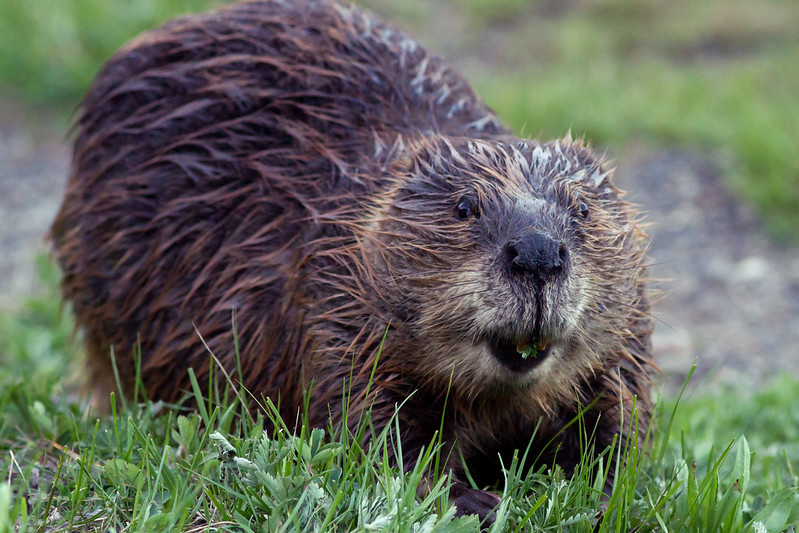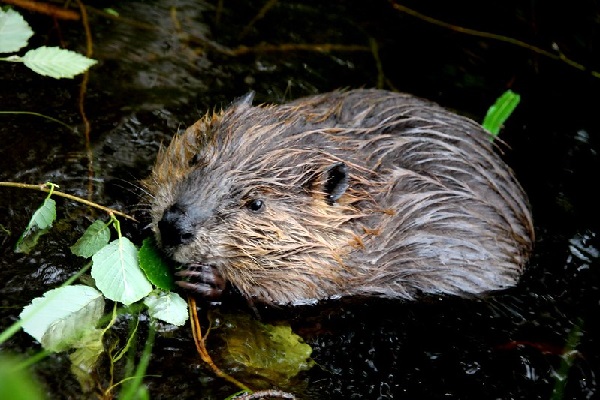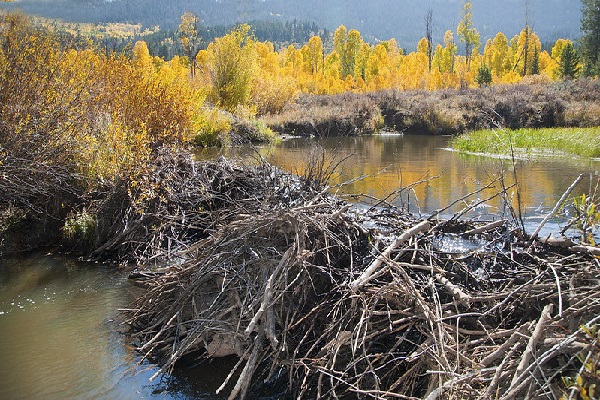
Beavers feed primarily on the bark, twigs, and leaves of a tree such as aspen, willow, and birch. They are able to digest the tough cellulose in these plants thanks to their unique digestive system which includes a large cecum. Beaver teeth never stop growing, which is why they constantly gnaw on trees and other wood material that fell to maintain their teeth, and this behavior is particularly important for the survival of beaver colonies. Female beavers play an important role in the family group by raising the young kits and teaching them how to swim and other important skills such as foraging and building.
Beavers’ habitat and range are closely linked to their ability to modify the environment to suit their needs. Their dam and lodge create important wetland habitats that support a variety of plant and animal life and play a key role in regulating water flow and improving water quality on a river, creek, pond, or lake. The complex social behaviors of beavers and diet beavers also make them a fascinating subject of study, as they communicate with each other through a variety of vocalizations, scent markings, and tail slap. In this article, we will explore the diverse habitats and what is the range of a beaver around the world, and how they interact with their environment to create unique ecosystems.

Distribution of Beavers
The distribution of beavers is widespread, with the species found on every continent except for Australia, Africa and Antarctica. The North American beaver (Castor Canadensis), also known as the Canadian beaver, is the most well-known species and is found throughout Canada and the United States. In fact, North America is home to the majority of the world’s beaver population. The Eurasian beaver, on the other hand, is found in Europe and Asia, from Scandinavia to Mongolia.
The distribution of beavers varies widely depending on the species, with some populations thriving in remote wilderness areas, while others have adapted to urban environments. In some areas, beavers have been introduced as part of conservation efforts or for commercial purposes, leading to changes in local ecosystems. For example, the introduction of North American beavers to South America has had a significant impact on the environment, as they have no natural predators in their new habitat and are causing damage to wetlands and waterways.
Despite the differences in distribution, all beavers share common characteristics and behaviors that have allowed them to survive and thrive in a variety of environments. From their signature flat scaly tail and webbed hind feet, to their ability to communicate with each other through scent and sound, beavers are fascinating creatures with a unique place in the natural world.

Impact of Human Activity on Beaver Range and Habitat
The impact of human activity on the range and habitat of beavers has been significant, and it continues to be a major threat to their survival. One of the biggest factors affecting beaver populations is the destruction of their habitat. Humans have altered the landscape in many ways, including building dams, clearing forests, and constructing buildings, which has resulted in the loss of many natural habitats suitable for beavers.
In addition, human hunting and trapping for beaver pelts have contributed to a significant decline in beaver populations throughout history. Beavers were hunted for their pelts, which were used to make clothing and other items. This led to the near extinction of the North American beaver, which was once the most sought-after fur in the world. Conservation efforts and regulations have helped to stabilize populations of beavers, but human activity still poses a threat.
Despite these challenges, beavers have adapted well to changing environments and can thrive in urban areas if given the opportunity. Many cities and towns have recognized the value of beavers and their role in maintaining healthy ecosystems. Efforts have been made to protect beaver dams and lodges and to promote coexistence with these fascinating animals.

Conserving and Protecting Beaver Populations and their Habitats
Conserving and protecting beaver populations and their habitats is crucial to ensure the long-term survival of these animals and the many benefits they provide to ecosystems. The conservation efforts involve a variety of strategies to protect beavers, including protecting their habitats, reducing human-wildlife conflicts, and reintroducing beavers to areas where they have been historically present.
Young beavers, in particular, are vulnerable and require specific protection measures. Eurasian beavers, for instance, are protected by law in many countries, and it is illegal to hunt or capture them. In addition, beavers are often affected by habitat loss and degradation, as well as water pollution, which can negatively impact their food sources such as aquatic plants and animals.
Conservation efforts also involve managing beaver populations to ensure their interactions with humans and human infrastructure are minimized. For example, organizations may work to prevent beaver dams and beaver lodges from causing flood or other damage to homes, roads, and other infrastructure. However, there are also ways to mitigate these effects without harming the beavers, such as installing water level control devices to manage water flow.
Need Help With Wildlife On Your Property?
AAAC Wildlife Removal Services can help you with any wildlife-related issues on your property, including those involving the largest rodent in North America, the beaver. Our team of professionals is trained to handle a variety of situations, including the removal of beaver dams and the relocation of beavers. We understand that beavers can be a vital part of the ecosystem, and our team takes great care to ensure their safe and humane removal.
Beavers are known for their ability to construct intricate beaver lodges, which can sometimes cause problems for homeowners. AAAC Wildlife Removal Services can provide solutions to these issues, while still respecting the natural behaviors of these animals. Our team is also equipped to handle young beavers that may have become separated from their mothers, and we work to ensure their safe return to their habitat. Trust us to help you protect your property while also preserving the important role that beavers play in the ecosystem.
Final Thoughts
Beavers play a crucial role in shaping their environments by building dams and lodges that create habitats for a diverse range of species. Despite their historical importance in the fur trade industry, their populations have recovered in recent years due to conservation efforts.
They are the largest rodent in North America and Eurasia and are known for constructing impressive beaver dams and lodges. Beavers mate for life and beavers communicate with each other through various vocalizations and physical gestures. Beaver’s diet consists mainly of bark, leaves, and woody plants. Unfortunately, human activity has had a significant impact on their habitats, but there are efforts to protect and conserve beaver populations. In case you need help with wildlife on your property, AAAC Wildlife Removal Services can provide assistance. Overall, castor canadensis is a valuable species that deserves our attention and protection.







